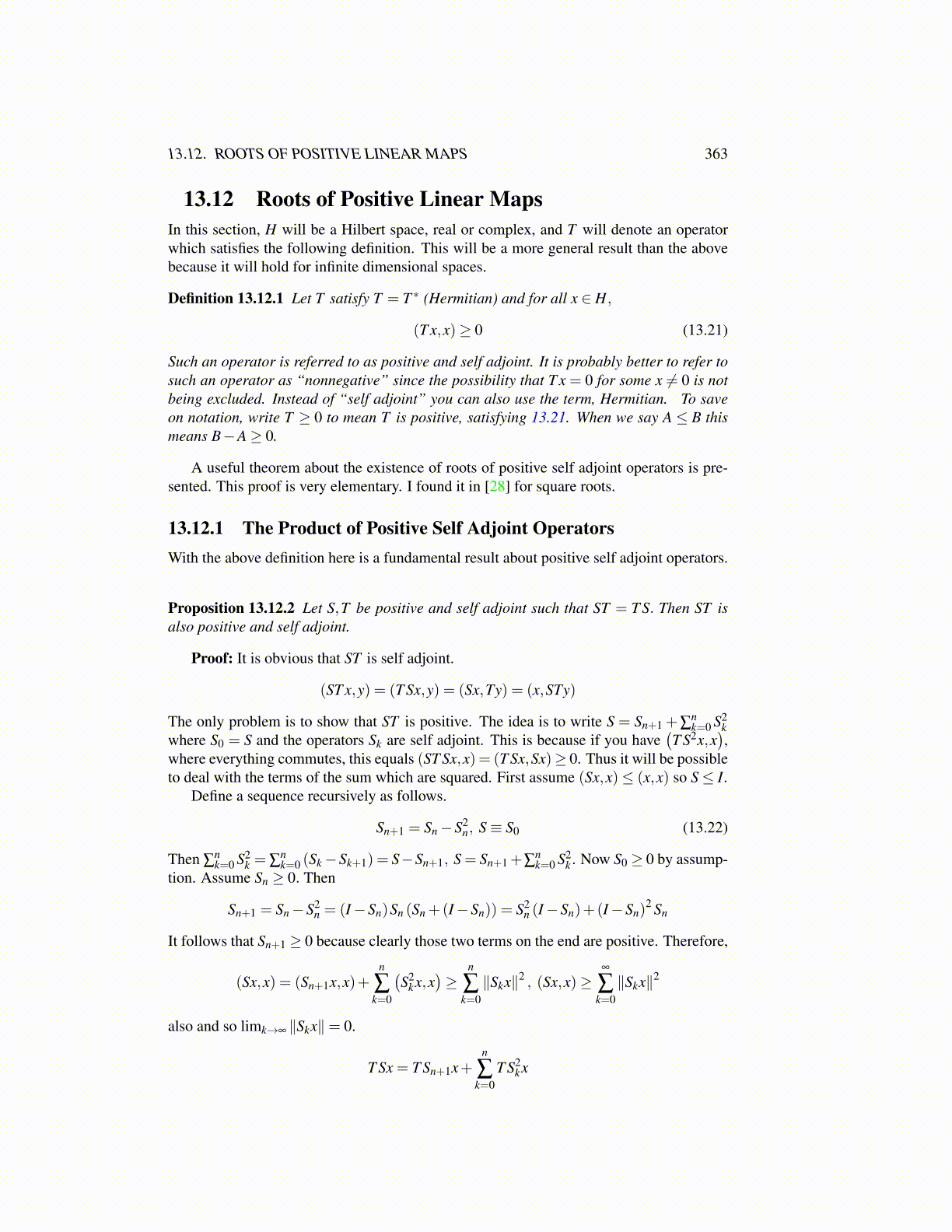
13.12. ROOTS OF POSITIVE LINEAR MAPS 363
13.12 Roots of Positive Linear MapsIn this section, H will be a Hilbert space, real or complex, and T will denote an operatorwhich satisfies the following definition. This will be a more general result than the abovebecause it will hold for infinite dimensional spaces.
Definition 13.12.1 Let T satisfy T = T ∗ (Hermitian) and for all x ∈ H,
(T x,x)≥ 0 (13.21)
Such an operator is referred to as positive and self adjoint. It is probably better to refer tosuch an operator as “nonnegative” since the possibility that T x = 0 for some x ̸= 0 is notbeing excluded. Instead of “self adjoint” you can also use the term, Hermitian. To saveon notation, write T ≥ 0 to mean T is positive, satisfying 13.21. When we say A ≤ B thismeans B−A≥ 0.
A useful theorem about the existence of roots of positive self adjoint operators is pre-sented. This proof is very elementary. I found it in [28] for square roots.
13.12.1 The Product of Positive Self Adjoint OperatorsWith the above definition here is a fundamental result about positive self adjoint operators.
Proposition 13.12.2 Let S,T be positive and self adjoint such that ST = T S. Then ST isalso positive and self adjoint.
Proof: It is obvious that ST is self adjoint.
(ST x,y) = (T Sx,y) = (Sx,Ty) = (x,STy)
The only problem is to show that ST is positive. The idea is to write S = Sn+1 +∑nk=0 S2
kwhere S0 = S and the operators Sk are self adjoint. This is because if you have
(T S2x,x
),
where everything commutes, this equals (ST Sx,x) = (T Sx,Sx)≥ 0. Thus it will be possibleto deal with the terms of the sum which are squared. First assume (Sx,x)≤ (x,x) so S≤ I.
Define a sequence recursively as follows.
Sn+1 = Sn−S2n, S≡ S0 (13.22)
Then ∑nk=0 S2
k = ∑nk=0 (Sk−Sk+1) = S−Sn+1, S = Sn+1+∑
nk=0 S2
k . Now S0 ≥ 0 by assump-tion. Assume Sn ≥ 0. Then
Sn+1 = Sn−S2n = (I−Sn)Sn (Sn +(I−Sn)) = S2
n (I−Sn)+(I−Sn)2 Sn
It follows that Sn+1 ≥ 0 because clearly those two terms on the end are positive. Therefore,
(Sx,x) = (Sn+1x,x)+n
∑k=0
(S2
kx,x)≥
n
∑k=0∥Skx∥2 , (Sx,x)≥
∞
∑k=0∥Skx∥2
also and so limk→∞ ∥Skx∥= 0.
T Sx = T Sn+1x+n
∑k=0
T S2kx